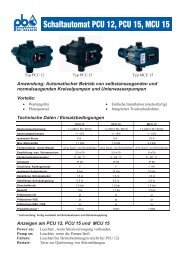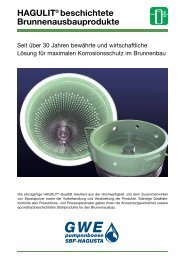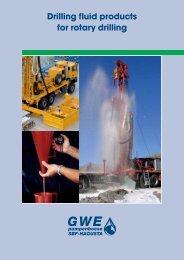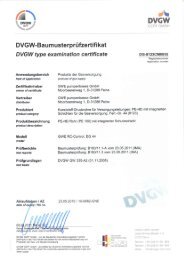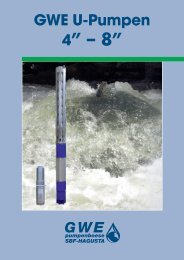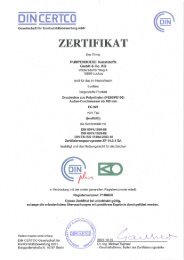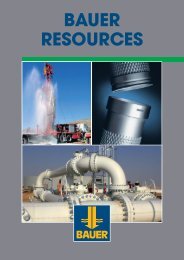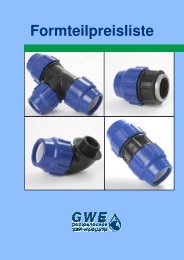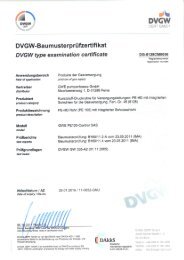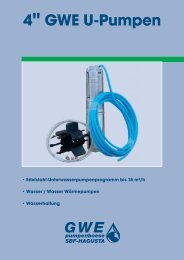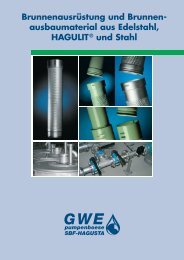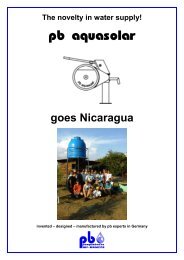Sealings for well construction - GWE German Water and Energy GmbH
Sealings for well construction - GWE German Water and Energy GmbH
Sealings for well construction - GWE German Water and Energy GmbH
Create successful ePaper yourself
Turn your PDF publications into a flip-book with our unique Google optimized e-Paper software.
<strong>Sealings</strong> <strong>for</strong> <strong>well</strong><br />
<strong>construction</strong><br />
Clay sealings<br />
Cement grouts
<strong>Sealings</strong> <strong>for</strong> <strong>well</strong> <strong>construction</strong><br />
General<br />
The <strong>construction</strong> of <strong>well</strong>s <strong>for</strong> the purposes of extracting, monitoring<br />
or surveying groundwater reservoirs usually involves<br />
drilling through cohesive sediments which, in their undisturbed<br />
state, represent hydraulic barriers. These sediments separate<br />
groundwater reservoirs of differing quality <strong>and</strong> mineralisation<br />
<strong>and</strong> prevent contaminated waters from influencing deeper<br />
aquifers. There<strong>for</strong>e, in general, if boreholes are completed<br />
as water or monitoring <strong>well</strong>s, all per<strong>for</strong>ated clay beds must<br />
be reconstructed by the installation of suitable sealing products.<br />
As a leading manufacturer <strong>and</strong> supplier of <strong>well</strong> <strong>construction</strong><br />
materials, the <strong>GWE</strong> Group provides a professional range of<br />
highly effective sealing products based on s<strong>well</strong>ing clays <strong>and</strong><br />
ready-made clay-cement mixtures.<br />
Sealing clays vary in shape, s<strong>well</strong>ing capacity, structural<br />
stability, inherent density <strong>and</strong> geophysical detectability. The<br />
installation in the borehole is completed by pouring the clay<br />
pellets into the <strong>well</strong>, where they settle down at the hole bottom.<br />
Plumb-line checks indicate that the seal has been placed at<br />
the correct depth. Limits are set by the depth of the borehole<br />
<strong>and</strong> the annular geometry.<br />
Pumpable grouts based on a special clay-sealant cement<br />
recipe can also be used. Stable slurries are produced by mixing<br />
the grout material with water.<br />
Requirements<br />
The core requirements <strong>for</strong> sealants in <strong>well</strong> <strong>construction</strong> are:<br />
• Effective seal in finished <strong>well</strong>, without any leakages between<br />
different layers <strong>and</strong> borehole wall<br />
• Safe <strong>for</strong> potable water<br />
• Secure <strong>and</strong> accurate placement<br />
• Detecable by means of geophysical logging<br />
Clay sealings<br />
High s<strong>well</strong>ing clay products have proven to be particularly<br />
successful in the sealing of <strong>well</strong>s. These products are composed,<br />
to a large extent, of the clay mineral bentonite.<br />
The principal advantage of bentonite clay sealings over less<br />
s<strong>well</strong>ing materials composed of kaolinitic/illitic clays lies in<br />
their ability to exp<strong>and</strong> in volume <strong>and</strong> to create s<strong>well</strong>ing pressure.<br />
This compression pushe the seal firmly to the surfaces<br />
(casing/borehole wall) which prevents any leakage through<br />
its superior sealing properties.<br />
Place of installation – Well annulus<br />
As a result of the annular geometry, the gravitional <strong>for</strong>ce is reduced.<br />
The implementation of filler material (e.g. gravel,<br />
s<strong>and</strong>s) results in less compaction of the underlying clay seals<br />
due to relative low constant vertical loads, which are caused<br />
by friction of the fill material along the borehole wall. This is<br />
all the more the case in small diameter <strong>well</strong>s, with the result<br />
that previously placed clay seals are not subject to any appreciable<br />
compaction.<br />
Pressure N/cm2<br />
Annulus pressure distribution ø 150/75 mm<br />
1,00000<br />
0,90000<br />
0,80000<br />
0,70000<br />
0,60000<br />
0,50000<br />
0,40000<br />
0,30000<br />
0,20000<br />
0,10000<br />
0,00000<br />
0,00 20,00 40,00 60,00 80,00 100,00 120,00<br />
Depth m<br />
Diagram 1: Load distribution in a gravel-filled <strong>well</strong> annulus.<br />
Ø hole 150 mm / Ø casing NORIP DN 65<br />
Vertical<br />
load pressure<br />
Lateral<br />
load pressure<br />
This must be taken into account when determining the test parameters<br />
<strong>for</strong> investigating the effectiveness of clay materials in<br />
borehole sealing. To ensure that measurements of the sealing<br />
behaviours are taken under realistic conditions, vertical loads<br />
of max. 1 N/cm 2 should be applied in the test cells (Diagram<br />
1). Greater vertical loads would induce an inadmissable compaction<br />
of the sample; only if the s<strong>well</strong>ing pressure from the<br />
clay sample is higher than 1 N/cm 2 (Test 1 with constant volume)<br />
would this be acceptable.
Material characteristics<br />
Considering the special placement conditions, two different<br />
test set-ups have proven successful in providing comprehensive<br />
in<strong>for</strong>mation on the characteristics of clay sealings when<br />
used in <strong>well</strong> <strong>construction</strong>:<br />
Test 1 with constant volume<br />
Describes the case where the water-filled space is completely<br />
filled with poured-in clay pellets. Once the pore spaces in the<br />
clay filling have been closed through the s<strong>well</strong>ing process, the<br />
resulting s<strong>well</strong>ing pressure � <strong>and</strong> the coefficient of<br />
permeability kf are measured according to Darcy’s law.<br />
Test 2 with constant low pressure<br />
This describes the case where, <strong>for</strong> geometrical reasons, unfilled<br />
spaces are present, as it may occur in large reamed<br />
boreholes. If a low vertical pressure is applied (1 N/cm2 ), a<br />
measurable volume expansion V (depending on s<strong>well</strong>ing<br />
capacity) will be observed in the <strong>well</strong>. At the same time<br />
the coefficient of permeability kf can also be determined.<br />
(see top right graph)<br />
Typical values <strong>for</strong> high s<strong>well</strong>ing clay sealing:<br />
S<strong>well</strong>ing pressure �<br />
test 1: up to 10,0 N/cm 2<br />
Volume expansion<br />
test 2: 20 - 40 %<br />
Coefficient of permeability k f<br />
test 1 + 2: < 10 -10 m/s<br />
Effectiveness in salt water<br />
The ability of bentonite sealings to exp<strong>and</strong> in volume <strong>and</strong><br />
create s<strong>well</strong>ing pressure diminishes in mineralised water.<br />
Studies investigating sodium chloride waters <strong>and</strong> SBF Quellon<br />
WP at the Institute <strong>for</strong> Foundation <strong>and</strong> Soil Mechanics at<br />
the Technical University of Braunschweig have observed the<br />
following behaviour:<br />
Test series 1<br />
• Activation in tap water<br />
• Perfusion with salt water<br />
If the high s<strong>well</strong>ing clay pellets are first activated in fresh<br />
water, the clay seal in relation to sodium chloride water was<br />
proven effective to a concentration of 30 g/l.<br />
Limit 30 g NaCl/l<br />
Test series 2<br />
• Activation <strong>and</strong> perfusion with salt wasser<br />
If Quellon WP is introduced directly into salt water, the material<br />
characteristics of the clay seal are stable to a concentration<br />
of 5 g NaCl/l. At 10 g/l the coefficient of permeability<br />
increases by a power of ten to 10 -10 m/s. Higher salt loads<br />
cause a significant decrease in the s<strong>well</strong>ing capacity <strong>and</strong> the<br />
coefficient of permeability rises by several powers of ten.<br />
Limit 10 g NaCl/l<br />
1
S<strong>well</strong>ing capacity in fresh <strong>and</strong> salt water<br />
Fig. 1 Quellon HD dry / in deionised water / tap water / -<br />
salt water 10 g NaCl/l<br />
Geophysical detection of annulus backfilling<br />
2<br />
Clay materials that demonstrate s<strong>well</strong>ing capacities < 30%<br />
when placed freely under water, <strong>and</strong> hence are smaller than<br />
the pore volume of the clay filling, should only be used <strong>for</strong><br />
<strong>well</strong> sealing under certain conditions. In such cases there is<br />
a possibility that air pockets may remain in the filling, particularly<br />
at the boundaries (borehole wall/casing surface)<br />
which will then result in increased permeability. Large<br />
hydraulic gradients will consequently cause erosion that will,<br />
in the end, lead to the total failure the barrier, resulting in the<br />
fillers being rearranged above the seal.<br />
It is only possible to achieve effective borehole seals using<br />
low s<strong>well</strong>ing clay in holes of at least Ø > 400 mm due to the<br />
large vertical loads which result from the pouring process.<br />
For reasons previously mentioned, we recommend that only<br />
bentonite-type materials are used <strong>for</strong> smaller<br />
borehole/annulus diameters.<br />
Source Well Logging: BLM Storkow <strong>GmbH</strong>
Other characteristics of clay seals include:<br />
• Sinking behaviour / placement reliability<br />
• Shape<br />
• Structural stability<br />
• Geophysical detectability<br />
Vacuum-pressed clay pellets have proven advantages over<br />
granulated products in relation to placement reliability <strong>and</strong><br />
structural stability. Smooth, compact surfaces delay the s<strong>well</strong>ing<br />
process when the pellets sink down the borehole, thus<br />
reducing the risk of bridges or pile-ups <strong>for</strong>ming along the<br />
trajectory.<br />
Thanks to special mineral additives, products with special<br />
qualities, such as higher inherent density/sinking speed with<br />
magnetic properties <strong>and</strong> higher intrinsic radiation, are available<br />
which ensure reliable detection in <strong>well</strong> logging (see<br />
Diagram BLM Storkow <strong>GmbH</strong>).<br />
Our R&D Department will be pleased to advise you on a suitable<br />
choice of product.<br />
Cement grouts<br />
In addition to clay products <strong>for</strong> sealing <strong>well</strong>s <strong>and</strong> groundwater<br />
monitoring <strong>well</strong>s ready-made mixtures, like SBF-Troptogel<br />
B have also been successfully used in the creation of<br />
pumpable suspensions. These consist principally of:<br />
• Hydraulic binder<br />
• Low s<strong>well</strong>ing clay (kaolinite)<br />
• High s<strong>well</strong>ing clay (bentonite)<br />
• Special mineral additives <strong>for</strong> more advanced applications<br />
Clay cement suspensions can essentially be used <strong>for</strong> all sealing<br />
work in <strong>well</strong> projects, both <strong>for</strong> basic <strong>well</strong> decommissioning<br />
<strong>and</strong> <strong>for</strong> annular grouting in groundwater monitoring<br />
<strong>well</strong>s. By using tried <strong>and</strong> tested placement technologies, reliable<br />
<strong>well</strong> seals can be produced at great depths.<br />
Just as is the case <strong>for</strong> clay products, special mineral mixtures<br />
(<strong>for</strong> example with high natural gamma ray activity) are also<br />
available <strong>for</strong> pumpable grouts.<br />
This improves the material’s geophysical detectability. Meaningful<br />
geophysical measurements are an important basis <strong>for</strong><br />
qualitative assessment of remedial work, especially in the<br />
case of retrospective annular pressure grouting. Here, we<br />
are able to offer you SBF-Troptogel C as a suitable product<br />
<strong>for</strong> this purpose.<br />
Pumpable cement grouts also have advantages in completion<br />
of boreholes <strong>for</strong> the exploitation of geothermal energy.<br />
Their free-flowing consistency allows <strong>for</strong> a complete <strong>and</strong><br />
secure seal of built-in probe tubes, bends <strong>and</strong> spacers while<br />
at the same time reconstructing per<strong>for</strong>ated hydraulic barriers.<br />
Depending on requirements, simple sealant suspensions<br />
or filling compounds with high thermal conductivity can<br />
also be employed.<br />
Requirements<br />
Pumpable cement grouts <strong>for</strong> professional sealing of <strong>well</strong>s<br />
<strong>and</strong> groundwater monitoring <strong>well</strong>s should have the following<br />
properties:<br />
• Absolute volume consistance<br />
• kf- values < 10-10 m/s<br />
• Excellent system seal<br />
• No heat generation during setting<br />
• Sedimentation-stable<br />
• High resistance against (or concrete-aggressive waters.)<br />
• Filter stability at permeable barriers<br />
• Geophysically detectable<br />
• Hygenically safe <strong>for</strong> potable water<br />
Mixing<br />
High-speed mixers have proven effective in making up<br />
cement grouts. These agitate the binder/clay mixture <strong>and</strong>, if<br />
the correct quantity of material is added, produce a colloidal<br />
grout (a lump-free, stable suspension). It is important to select<br />
the correct capacity of mixer <strong>for</strong> the particular grouting project<br />
at h<strong>and</strong> so that the required quantity of suspension can<br />
be produced in the available time. For colloidal mixing <strong>and</strong><br />
injection of Howable grout slurries we recommend the use of<br />
compact hydraulic driven plants, like the IEC-404H, produced<br />
from our sister company MAT (Mischanlagentechnik<br />
<strong>GmbH</strong>).<br />
Guidelines relating to suspension characteristics (e.g. Marsh<br />
times, density, processing times) must be observed <strong>and</strong> documented.<br />
3
Grouting process<br />
For professional annular seals in deep <strong>well</strong>s or monitoring<br />
<strong>well</strong>s, it is advisable to use the grouting process developed<br />
by Preussag which is registered under patent no. DE 3 84 13<br />
16 C2 (<strong>construction</strong> version 1).<br />
The SBF-NORIP casing system has been specially designed<br />
<strong>for</strong> use with this method <strong>and</strong> allows the cement to be grouted<br />
into the annulus from the interior of the <strong>well</strong>. Built into the<br />
blank casing section above the screened zone is a cementation<br />
valve, through which the suspension is pumped to surface<br />
via a pistonpacker. There are numerous advantages to this<br />
method in comparison to conventional placement techniques:<br />
• Only small hole diameters required<br />
• Efficient use of material<br />
• Short filling times<br />
• Uni<strong>for</strong>m, homogenous annular backfill<br />
• Seals depths up to 500 m<br />
A detailed process description is available on request.<br />
In <strong>construction</strong> version 2, the grout suspension can also be<br />
applied directly into the annular space using the conventional<br />
tremie method. The depth <strong>for</strong> which this method may be<br />
used is limited. On oneside, the frictional resistances increase<br />
dramatically when the tremie line is installed, <strong>and</strong> on the<br />
other side, the large borehole diameters that are required<br />
pose a considerable costfactor.<br />
4<br />
Construction 1 Construction 2<br />
Principle drawing of filling process<br />
Construction 1: Pat. grouting process<br />
Preussag<br />
Construction 2: Filling process via<br />
annular<br />
The cement job is completed when the slurry which leaves the<br />
borehole shows identical properties like suspension which is<br />
pumped into the <strong>well</strong>.
Overview of clay sealing products – Recommended applications<br />
Mikolit 00<br />
Compactonit<br />
TT 20<br />
Compactonit<br />
10/80<br />
Quellon WP Compactonit<br />
10/200<br />
Mikolit 300<br />
300 M<br />
Quellon HD<br />
Pellets with<br />
low<br />
s<strong>well</strong>ing capacity<br />
Pellets with<br />
low<br />
s<strong>well</strong>ing capacity<br />
Pellets with<br />
moderate<br />
s<strong>well</strong>ing capacity<br />
Pellets with<br />
high s<strong>well</strong>ing<br />
capacity<br />
Pellets with<br />
high s<strong>well</strong>ing<br />
<strong>and</strong> gamma ray<br />
activity<br />
Pellets with<br />
moderate s<strong>well</strong>ing<br />
capacity/300M<br />
has magnetic<br />
behaviours<br />
Pellets with high<br />
s<strong>well</strong>ing capacity,<br />
<strong>and</strong> increased<br />
density with magnetic<br />
behaviours<br />
Product<br />
characteristics<br />
++ ++ ++ ++ ++ 0 0<br />
Sealing behaviours<br />
++ + + + + + +<br />
Sinking behaviours<br />
during installation<br />
++ + ++ 0 0 0 0<br />
Geophysical<br />
detectability<br />
in large diameter<br />
<strong>well</strong>s > 400 mm<br />
in large diameter<br />
<strong>well</strong>s > 400 mm<br />
in cased <strong>well</strong>s<br />
in <strong>well</strong>s drilled<br />
with rotary mud<br />
techniques<br />
in <strong>well</strong>s drilled<br />
with rotary mud<br />
techniques / seal<br />
is detectable with<br />
gamma ray<br />
logging<br />
in cased <strong>well</strong>s /<br />
placement of<br />
300M is<br />
detectable with<br />
magnetic logging<br />
in <strong>well</strong>s<br />
> 100 m drilled<br />
with rotary mud<br />
techniques / seal<br />
is detectable with<br />
magnetic logging<br />
Recommended<br />
applications<br />
Assessment key: ++ very good / + good / 0 moderate<br />
7
Products <strong>for</strong> <strong>well</strong> <strong>construction</strong><br />
312.003.2



